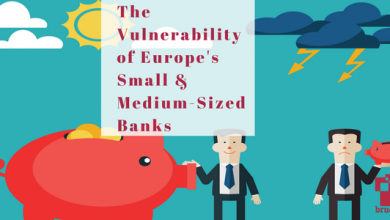This piece was published by Bruegel. The aim of the banking union was to break the toxic link between banks and states. One way of achieving this is by increasing cross border banking through mergers and acquisitions. This blog shows that little has changed in M&A activity since the banking union was launched. In fact, we seem to be witnessing a slight re-nationalisiation of banking consolidation.
European banking union was established to break the vicious circle between banks and sovereigns, the danger of which was so clearly expose by the sovereign debt crisis. One way to measure success in this aim would be an increase in cross-border bank mergers and acquisitions (M&A). After all, if there is no link between banks and their national sovereign, mergers should be just as likely across borders as within countries. Of course, various barriers to cross-border mergers will remain even in a completed banking union: business reasons, policy differences outside the realm of banking policies; language and cultural barriers.
Nevertheless, differences between national banking policies, supervisory practices and fiscal backstops should have disappeared with banking union. This should make cross-border mergers less worrying and thereby more likely. Moreover, there is an argument in favour of cross-border M&A within the banking union: diversification of credit risk, given the difference in business and financial cycles across euro-area countries.
In this blog post, we analyse banking M&A in the euro area to assess whether there has been any increase in cross-border deals since the launch of banking union. We also investigate whether the nature of the deals has changed.
Figure 1. Number of EA-19 banks acquired by other banks, by buyer’s region
Despite the single currency, cross-border M&A within the euro area are rare. Figure 1 shows that the great majority of M&A over the past decade have been domestic, and there is no clear evidence of a trend over time. In particular, there are no signs that merger activity has changed since the beginning of banking union.
Another issue which could signal enhanced banking convergence in the euro area is whether cross-border acquisitions consist mainly of minority or controlling stakes. Looking at Figure 2 we see that controlling stakes account for 71% of domestic deals. This is in sharp contrast with cross-border acquisitions, where most deals consist of minority stakes. It is also worth noting that acquisitions of euro-area banks by other euro-area banks are only slightly more likely to be the purchase of a controlling stake than acquisitions from outside the euro area.
But has banking union changed this picture? Do we observe an increase in mergers where the buyer takes control? If we divide pre-banking union M&A from those since the launch of banking union, we see the share of control-taking acquisitions has actually fallen for cross-border M&A inside the euro area: from 63% to 57%. The opposite movement is visible in domestic M&A, which have increasingly become controlling acquisitions (Figure 3, Panels 1 and 2).
The data thus suggest that the banking consolidation process appears to be largely domestic. We do not yet see a clear increase in cross-border activity. In fact, cross-border M&A activity seems to be less about controlling shares than it was before. It seems that banking union is still far from achieving its objective. Banking union is not leading to domestic-like M&A behavior across borders within the euro area. And therefore we are ultimately still not breaking the vicious circle between banks and sovereigns.
The reasons are still up for debate. Is it the incomplete policy framework? If so, what’s the key bottleneck – supervisory ringfencing, deposit insurance, consumer protection? Or is it rather because we have still not got back to a “really investable” banking sector in the euro area, in which case the pattern can be expected to change in the years ahead? The coming years will tell.
Figure 2. M&As by type of stake (share of total during 2006-2017)
Figure 3. M&As by type of stake – pre and post-BU

